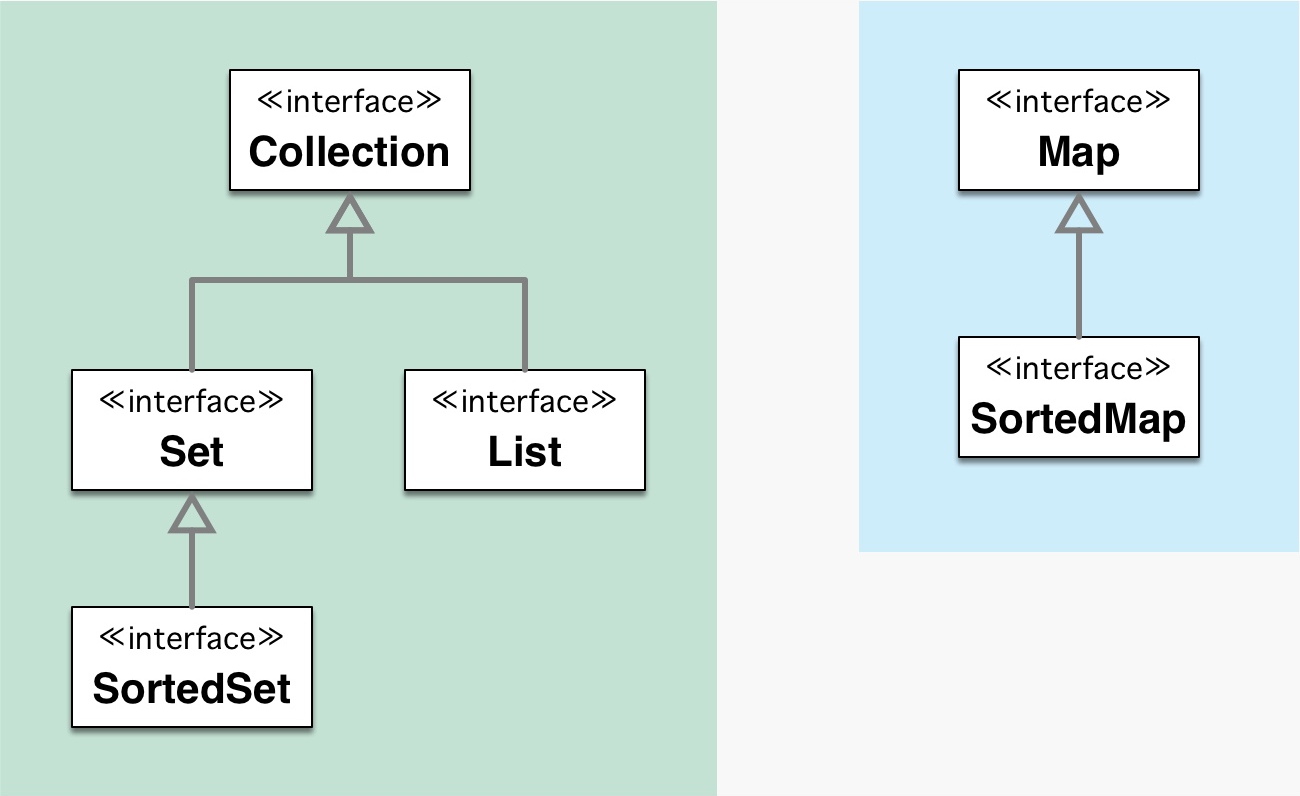Java Collections Library
Overview
Definitions
Set
- a collection that cannot contain duplicate elements.
- a collection that does not guarantee the order of its elements.
SortedSet
- a collection that cannot contain duplicate elements.
- a collection that is continuously sorted by its elements natural order or by a custom order.
List
- a collection that can contain duplicate elements.
- a collection that maintains and guarantees the order of its elements.
Map
- a collection that maps keys to values.
- a map cannot contain duplicate keys.
- a key can map to one and only one value.
- a map can contain duplicate values.
- a map’s keys are not in a predictable or guaranteed order.
SortedMap
- a collection that maps keys to values.
- a sorted map cannot contain duplicate keys.
- a key can map to one and only one value.
- a sorted map can contain duplicate values.
- a sorted map’s keys are continuously sorted by its elements natural order or by a custom order.
API
- Java API
- The primary methods for the Collection interface
boolean add(E e)boolean contains(Object o)Iterator<E> iterator()int size()
- The primary methods for the Map interface.
boolean containsKey(Object key)Set<Map.Entry<K,V>\> entrySet()V get(Object key)Set<K> keySet()V put(K key, V value)int size()
Concrete Implementations
Set => HashSet
- A normal set that has no predictable order
SortedSet => TreeSet
- A sorted set whose elements are sorted in their natural order.
List => ArrayList
- A normal list that maintains the order in which the elements were added.
Map => HashMap
- A normal map whose keys are not ordered.
SortedMap => TreeMap
- A sorted map whose keys are sorted in their natural order.
Lists
Create a List
// Java 4
List list = new ArrayList();
// Java 5-9
List<String> list = new ArrayList<String>();
Notice the type for the list? It’s a “best practice” to declare variables as an interface whenever possible. Why?
// If the compiler can infer the type we can just use "<>"
List<String> list = new ArrayList<>();
Add to a List
The add method is used to add to a list.
List<String> list = new ArrayList<>();
list.add("one");
list.add("two");
Display a List
Getting a quick view of a List.
System.out.println(list);
Output
[one, two]
- The easiest way to see the contents of a list that’s not too big, is to simply use a
System.out.println()with the list reference variable as the argument. - Question? With this technique, what method is called on each element in
list?
Iterating through a List
// Iteration the java 1.4 way.
System.out.println("Iteration the java 1.4 way");
for (Iterator iterator = list.iterator(); iterator.hasNext();){
System.out.println(iterator.next());
}
// Iteration the java 5-9 way. We will use this!
System.out.println("Iteration the java 5-9 way");
for (String element : list){
System.out.println(element);
}
Output
Iteration the java 1.4 way
one
two
Iteration the java 5-9 way
one
two
Complete demo class
package java112.labs1;
import java.util.*;
/**
* @author Eric Knapp
* class ListDemo
*
*/
public class ListDemo {
public void run() {
List<String> list = new ArrayList<>();
list.add("one");
list.add("two");
System.out.println(list);
System.out.println();
System.out.println("Iteration the java 1.4 way");
for (Iterator iterator = list.iterator(); iterator.hasNext();){
System.out.println(iterator.next());
}
System.out.println();
System.out.println("Iteration the java 5-9 way");
for (String element : list){
System.out.println(element);
}
}
public static void main(String[] args) {
ListDemo demo = new ListDemo();
demo.run();
}
}
Lab time!
Sets
Create a Set
// Java 4
Set set = new HashSet();
// Java 5-9
Set<String> set = new HashSet<>();
Add to a Set
// What happens to the duplicates?
set.add("one");
set.add("one");
set.add("two");
set.add("two");
set.add("two");
set.add("two");
set.add("three");
set.add("three");
Display a Set
Getting a quick view of a Set.
// Just like a list
System.out.println(set);
Output
[one, three, two]
Hmm, the dups are gone!
Iterating through a Set
// Iteration the java 1.4 way
System.out.println("Iteration the java 1.4 way");
for (Iterator iterator = set.iterator(); iterator.hasNext();){
System.out.println(iterator.next());
}
// Iteration the java 5-9 way. This is the way we'll do it!
System.out.println("Iteration the java 5-8 way");
for (String element : set){
System.out.println(element);
}
Output
Iteration the java 1.4 way
one
three
two
Iteration the java 5-8 way
one
three
two
Complete Set demo
package java112.labs1;
import java.util.*;
/**
* @author Eric Knapp
* class SetDemo
*
*/
public class SetDemo {
public void run() {
Set<String> set = new TreeSet<>();
set.add("one");
set.add("one");
set.add("two");
set.add("two");
set.add("two");
set.add("two");
set.add("three");
set.add("three");
System.out.println(set);
System.out.println();
System.out.println("Iteration the java 1.4 way");
for (Iterator iterator = set.iterator(); iterator.hasNext();){
System.out.println(iterator.next());
}
System.out.println();
System.out.println("Iteration the java 5-8 way");
for (String element : set){
System.out.println(element);
}
}
public static void main(String[] args) {
SetDemo demo = new SetDemo();
demo.run();
}
}
